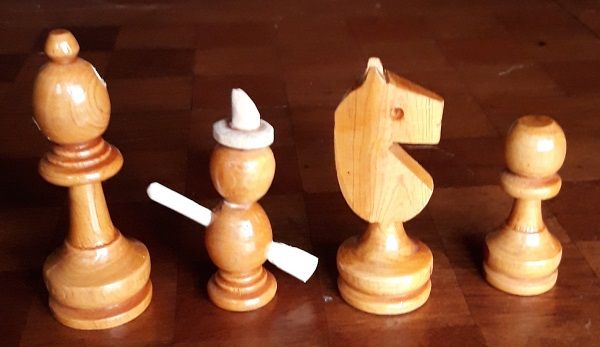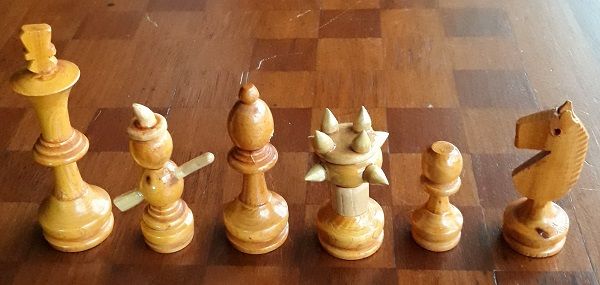List of unconventional pieces.


Guard: Move similar to the king, i.e. in all directions one square.

The most common are the bishop-knight compound and the rook-knight compound. Appearing in dozens of different variants under almost as many different names.
Also very amusing:

Note that a non-royal piece moving as King is usually called Man or Commoner. 'Guard' is usually reserved for pieces that step one or jump two squares in all 8 principal directions.
The number of possible pieces is almost infinite, even if you limit it to 'regular' pieces, i.e. pieces that just move from one square to another without affecting what happens / may happen on any other square. Pieces that violate that rule (e.g. by annihilating material not on their target square, or displacing such material as a side effect of their move) can potentially be even larger in number, although one finds them in Chess variants only rarely. Even for regular pieces the moves they are allowed to make themselves might depend on occupation of squares they do not visit (e.g. whether they can /cannot / must jump other pieces).

The name 'Emperor' has been used for many different pieces, because it is an obvious choice for a royal piece more powerful than a King. In the historic game Maka Dai Dai Shogi the Empror is a 'universal leaper', i.e. it is allowed to always move to any other square of the board, no matter where it currently is, and no matter how the board is occupied, even if the move is a capture. The only exception is that it cannot capture a royal piece if the latter is protected (i.e. recapture is possible).
In Superchess an Emperor is a King that also can also move two squares forward or backward.

I keep on finding "hawks" being referenced continually.
The Hawk is a pure leaper. In Musketeer Chess, the Hawk attacks by jumping over pieces 2 to 3 squares orthogonally or diagonally in any direction. The Hawk is a dangerous piece, but it’s also vulnerable as it cannot protect itself from the short-range attacking pieces. You can imagine attacking the opponent king at the opening (especially before castling) with mating patterns.
-MusketeerChess.net

Probably the best known Hawk is that of Seirawan Chess, where the ubiquitous Knight+Bishop and Knight+Rook compounds were renamed to Hawk and Elephant. Because Seirawan actually had pieces designed for those by the House of Staunton to promote his variant, beautiful Elephant and Hawk pieces are commercially available. Because of their availability Musketeer Chess made use of them (in addition to having several other pieces custom made), but with a completely different move.
In Musketeer Chess the BN and RN compound are known by their most-popular names 'Archbishop' and 'Chancellor', introduced by Capablanca, for his variant 'Capablanca Chess'. This was merely a re-invention, though; a variant almost identical to Capablanca Chess was already introduced in the 17th century by Pietro Carrera, who named these pieces 'Champion' and 'Centaur'. Musketeer Chess uses its own piece designs for Archbishop and Chancellor. (Which, unsurprisingly, do not look like hawks or elephants.)
As far as I know a Hawk with the move described in the previous posting is unique to Musketeer Chess and this forum. I also haven't seen this move on a piece with another name. The Japanese kanji for 'hawk' seems to be the same as for 'falcon', and many Shogi variants have a piece with this kanji written on it, but the English names then usually translate it as 'falcon' (e.g. Horned Falcon, Flying Falcon, Raiding Falcon, Tenacious Falcon). The only exception is the Lion Hawk of Tenjiku Shogi.

The builder moves one square orthogonally, but cannot capture. Pieces adjacent to the builder ( including diagonally) temporarily inherit each other's properties. For example, a pawn next to a builder which is also next to a queen can temporarily move like a queen.


Here's some graphics for some of the pieces:
Guard: moves as king but not affected by check.



(The first is the "Sage" from Courier Chess played in 13th century which moves the same as a king or guard)
I also like the "Elite Guard". This graphic might be what variant chess looks like in the future.
 (graphic by BattlechessGN18)
(graphic by BattlechessGN18)
Hawk: jumps 2 or 3 squares in queen's directions (Musketeer definition).


Angel - protects adjacent friendly pieces from capture.


Builder - pieces next to the builder inherit each others abilities.

Joker - moves as the piece last moved by the opponent.

Some of the other pieces mentioned here might be less common, and I didn't have graphics for them. I might add one or two others tomorrow.![]()


I actually meant that I saw emperor chess already, I can't go to caesar chess, though, it just puts me at emperor chess.

I've heard that some variants include an unconventional piece that on any given turn can move like a rook, or like a bishop. It's basically two pieces in one. I can't seem to recall what it's called though...

I've heard that some variants include an unconventional piece that on any given turn can move like a rook, or like a bishop. It's basically two pieces in one. I can't seem to recall what it's called though...
The original names of this variant when it first appeared were:
Queens Chess
Mad Queens Chess
The Enraged Lady of Chess (French)
It caused some outrage when it first appeared, some men complained that a female piece should not be allowed to be so powerful, this is actually true, it was medieval Europe after all.
One theory is that a powerful new Spanish Queen was inaugurated and this lead to the creation of this powerful new piece but nobody is quite certain how and when it first appeared, probably in Spain but possibly in Italy.
Later on it was just called chess once it became the most popular variant, the older chess with the ancient Queen moving one step on the diagonal basically died within a few decades after the modern Queen was introduced.

I tried to make a physical chess piece for the witch. I had a chess set with one missing piece, so I cut up some other pieces and combined them to make this. I won't say which pieces were cut to make the witch. Others can try to figure out.![]()


